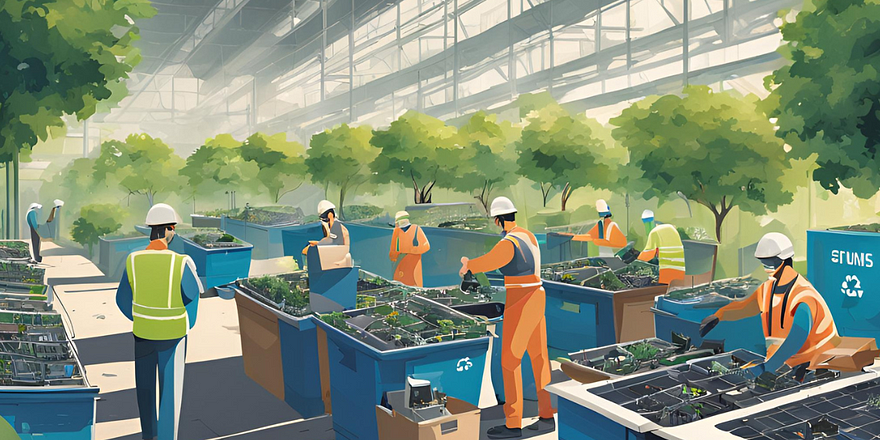The Green Solution for Electronic Waste
The Green Solution for Electronic Waste

In today’s fast-paced digital age, technology is advancing at a breakneck speed. Each year, new gadgets, from smartphones to laptops and home appliances, flood the market, enticing consumers to upgrade to the latest models.
As we replace old devices with new ones, we are left with a growing environmental challenge: what to do with our outdated electronics.
This problem has led to the rise of e-waste collection centers, which play a crucial role in managing electronic waste in an environmentally responsible manner.
Understanding E-Waste and Its Impact
Electronic waste, or e-waste, refers to discarded electronic devices, such as computers, mobile phones, televisions, and other consumer electronics.
When these items are thrown away carelessly, they often end up in landfills, where they can have serious environmental and health consequences.
Many electronic devices contain harmful substances like lead, mercury, and cadmium, which can leach into the soil and water systems, contaminating ecosystems and posing risks to human health.
The sheer volume of e-waste generated globally is staggering. According to the Global E-Waste Monitor, the world produced a record 53.6 million metric tons of e-waste in 2019, and this number is expected to rise.
With the rapid increase in electronic device consumption, it’s clear that a sustainable solution is needed.
E-waste collection centers offer a green solution, enabling responsible disposal and recycling of electronic devices.
What Are E-Waste Collection Centers?
An e-waste collection center is a facility where individuals and businesses can bring their old or unused electronics for proper disposal.
These centers are designed to collect, sort, and recycle electronic devices, ensuring that hazardous materials are safely removed and valuable components are recovered for reuse.
By diverting electronics from landfills and promoting recycling, e-waste collection centers contribute significantly to environmental sustainability.
One of the primary functions of an e-waste collection center is to separate recyclable materials from non-recyclable ones.
Many electronic devices contain valuable metals like gold, silver, copper, and palladium, which can be recovered and used to manufacture new products.
This not only reduces the need for mining raw materials but also conserves energy and reduces greenhouse gas emissions.
The Importance of E-Waste Collection Centers

- Environmental Protection: E-waste collection centers help prevent hazardous chemicals from entering the environment.
- When electronics are dumped in landfills, toxins can seep into the soil and water, causing pollution that harms wildlife and human health.
- By properly disposing of e-waste through a collection center, you can ensure that harmful substances are contained and treated according to environmental safety standards.
2. Resource Conservation: Many of the materials used in electronics, such as metals, plastics, and glass, can be recycled and reused.
E-waste collection centers make it possible to recover these valuable materials, reducing the need for raw material extraction and conserving natural resources.
This contributes to a circular economy, where products are reused, recycled, and remanufactured, minimizing waste.
3. Reducing Greenhouse Gas Emissions: Manufacturing electronic devices from scratch requires a substantial amount of energy and resources.
By recycling e-waste, we can reduce the energy needed to produce new products. This, in turn, lowers greenhouse gas emissions associated with mining, manufacturing, and transporting raw materials.
E-waste collection centers play a vital role in this process by ensuring electronics are recycled efficiently.
4. Compliance with Regulations: Governments around the world are implementing stricter regulations on the disposal of electronic waste.
Many regions now require proper e-waste management to avoid legal consequences. E-waste collection centers provide an easy and accessible way for individuals and businesses to comply with these regulations, ensuring that e-waste is handled responsibly and in accordance with the law.
How E-Waste Collection Centers Operate
At an e-waste collection center, the process typically begins with the sorting of electronic devices. Items are sorted by type — computers, phones, televisions, etc. — and then dismantled to separate different materials.
Hazardous substances like batteries, mercury-containing components, and circuit boards are carefully removed and sent to specialized facilities for safe disposal.
Next, the recyclable materials are processed. Metals like copper and aluminum are extracted and purified for reuse, while plastics are shredded and sent to recycling facilities.
Components that cannot be recycled, such as certain types of plastics and non-recoverable materials, are disposed of in an environmentally friendly manner.
In many cases, e-waste collection centers also collaborate with certified e-recycling companies to ensure that the recycling process adheres to high environmental and safety standards. These partnerships help maximize the recovery of materials while minimizing environmental harm.
How You Can Participate
It’s easier than ever to do your part in addressing the e-waste crisis. Here’s how you can contribute:
- Find a local e-waste collection center: Many communities have designated e-waste collection centers where residents can drop off their old electronics. A quick search online will help you locate a nearby facility.
- Donate or sell functional electronics: Before taking your devices to an e-waste collection center, consider donating or selling them if they’re still in working condition.
- Many organizations accept old electronics for reuse, extending the life of the product and reducing waste.
- Recycle responsibly: Make sure that the e-waste collection center you use is certified and follows proper recycling standards. Look for centers that partner with reputable e-recycling companies to ensure your electronics are handled safely.
- Spread awareness: Educate your friends, family, and colleagues about the importance of proper e-waste disposal. waste material The more people who recycle their electronics, the greater the positive impact on the environment.
The Future of E-Waste Management
As technology continues to advance, the need for effective e-waste management will only grow.
E-waste collection centers are at the forefront of this movement, offering a green solution to one of the most pressing environmental challenges of our time.
By making it easier for individuals and businesses to recycle their electronics, these centers are helping to reduce the environmental footprint of modern technology.
In the future, we can expect e-waste collection centers to play an even larger role in sustainability efforts, as governments and industries increasingly recognize the importance of responsible e-waste management.
With continued innovation and public participation, the vision of a zero-waste, circular economy for electronics is within reach.
Conclusion
E-waste is an unavoidable byproduct of our digital world, but we can take steps to mitigate its impact.
E-waste collection centers offer a practical and sustainable solution to the growing problem of electronic waste. By properly disposing of old electronics, we can protect the environment, conserve resources, and reduce greenhouse gas emissions.
So, the next time you’re ready to upgrade your device, remember that an e-waste collection center is the green solution for managing your e-waste responsibly.
.jpg)